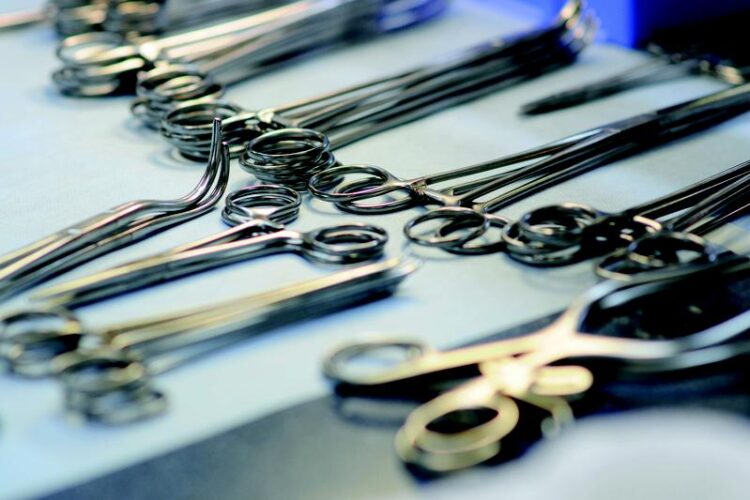All Scalpels to the OR, Please!

A surgical instrument tray can contain up to 160 scalpels, scissors, clamps and other tools.
Charité CFM Facility Management GmbH
Fraunhofer IPK and Charité CFM Facility Management GmbH are developing an AI-based system to automatically check trays of surgical instruments for completeness.
Everyday life in university hospitals: Surgical instruments are cleaned, disinfected, packed and sterilized in processing units for medical products. Around 3,500 instruments per day are prepared for surgical procedures under the strictest hygiene and quality standards and delivered to the operating rooms. A packing tray with the surface area of an A3 sheet can contain up to 160 scalpels, scissors, clamps and other instruments. Complaints from the operating room because a certain instrument is missing are therefore also an everyday occurrence in hospitals.
But is the clamp in question really missing, or can the surgical team simply not find it among the many very similar-looking instruments? Is the complaint justified or not? Service providers such as Charité CFM Facility Management GmbH can only investigate this question at their packing stations, where employees manually fill the surgical instrument trays and use a packing list to check whether all required tools are contained in one tray. The trays are then sealed and taken to the operating room. By scanning unique barcodes at fixed scanning points, CFM is able to locate surgical instrument trays even after they leave the reprocessing unit. Now the company also plans to use the latest AI-supported image processing technologies to ensure that the trays are on their way fully packed.
Researchers at the Fraunhofer Institute for Production Systems and Design Technology IPK are developing an assistance system that uses algorithms to automatically recognize surgical instruments. It consists of a detection system equipped with up to three cameras, an AI main system and a packing station as client unit. The AI main system is the processing unit, making it the heart of the technology. It serves to collect and store image data from surgical instruments and helps to train neural networks on the basis of this image data.
As algorithms, Convolutional Neural Networks (CNN) serve as a basis for a holistic approach to image processing and decision making. Compared to classical methods of image processing, they have the advantage that the AI automatically carries out complex parameter settings and continuously adjusts all weights and parameters to the available data in an automatic training process. The overall system will be implemented in accordance with the dual control principle to assist employees in the packing process and will also help documenting the work steps on the instrument trays and ensuring their quality. As a result, complaints about incorrectly loaded trays should be reduced.
In a feasibility study, the Fraunhofer experts have already successfully demonstrated that their technologies are suitable for automated recognition of surgical instruments. The sample comprised 156 different surgical instruments, which were automatically recognized based on a data set of a total of 9,672 images with a top 1 accuracy of 99.9 percent and a top 5 accuracy of 100 percent. The prototype which is now in development is scheduled to be available as an assistance system in the reprocessing unit for medical devices at the Charité’s Benjamin Franklin Campus from autumn 2021.
Wissenschaftliche Ansprechpartner:
Jan Lehr | Tel.: +49 30 39006-483 | jan.lehr@ipk.fraunhofer.de
Kathrin Kelterborn | Tel.: +49 30 450 573 376 | kathrin.kelterborn@cfm-charite.de
Ümit Ejder | uemit.ejder@cfm-charite.de
Weitere Informationen:
Media Contact
All latest news from the category: Information Technology
Here you can find a summary of innovations in the fields of information and data processing and up-to-date developments on IT equipment and hardware.
This area covers topics such as IT services, IT architectures, IT management and telecommunications.
Newest articles

Innovative 3D printed scaffolds offer new hope for bone healing
Researchers at the Institute for Bioengineering of Catalonia have developed novel 3D printed PLA-CaP scaffolds that promote blood vessel formation, ensuring better healing and regeneration of bone tissue. Bone is…

The surprising role of gut infection in Alzheimer’s disease
ASU- and Banner Alzheimer’s Institute-led study implicates link between a common virus and the disease, which travels from the gut to the brain and may be a target for antiviral…

Molecular gardening: New enzymes discovered for protein modification pruning
How deubiquitinases USP53 and USP54 cleave long polyubiquitin chains and how the former is linked to liver disease in children. Deubiquitinases (DUBs) are enzymes used by cells to trim protein…



